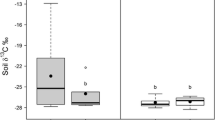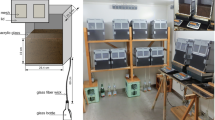Abstract
Subsurface-dwelling Aporrectodea tuberculata, a common earthworm in Upper-Midwest (USA) agricultural fields, may be a significant component of agroeco-systems with regard to soil mixing and preferential transport of water and chemicals. In this study we looked at effects of food residue placement and food type on A. tuberculata burrowing and soil turnover in two-dimensional Evans box microcosms. Four food residue placements mimicked patterns induced by primary tillage and two food types, readily available and natural food sources, with no food as a control. An average earthworm population of 100 earthworms m-2 was calculated to generate 1058 km ha-1 of new burrows and turnover 7.9 Mg ha-1 of soil in 1 week of activity at 20°C. Burrowing was random until food sources were encountered, at which time burrowing appeared to center around the food source.
Similar content being viewed by others
References
Abbott I, Parker CA (1981) Interactions between earthworms and their soil environment. Soil Biol Biochem 13:191–197
Boström U (1987) Growth of earthworms (Allolobophora caliginosa) in soil mixed with either barley, lucerne or meadow fescue at various stages of decomposition. Pedobiologia 30:311–321
Edwards WM, Shipitalo MJ, Owens LB, Norton LD (1989) Water and nitrate movement in earthworm burrows within long-term no-till cornfields. J Soil Water Conserv 44:240–243
Evans AC (1947) A method of studying the burrowing activities of earthworms. Ann Mag Nat Hist 14:643–650
Gomez KA, Gomez AA (1984) Statistical procedures for agricultural research, 2nd edn. Wiley, New York Sydney Toronto, pp 372–376
Hartenstein F, Hartenstein E, Hartenstein R (1981) Gut load and transit time in the earthworm Eisenia fetida. Pedobiologia 22:5–20
Kladivko E, Mackay AD, Bradford JM (1986) Earthworms a factor in the reduction of soil crusting. Soil Sci Soc Am J 50:191–196
Lavelle P (1988) Earthworm activities and the soil system. Biol Fertil Soils 6:237–251
Lee KE (1985) Earthworms — their ecology and relationship with soils and land use. Academic Press, Sydney
Martin NA (1982) The interaction between organic matter in soil and the burrowing activity of 3 species of earthworms (Oligochaeta: Lumbricidae). Pedobiologia 24:185–190
Roth CH, Joschko M (1991) A note on the reduction of runoff from crusted soil by earthworm burrows and artificial channels. Z Pflanzenernaehr Bodenkd 154:101–105
Scheu S (1987) The role of substrate feeding earthworms (Lumbricidae) for bioturbation in a beechwood soil. Oecologia 72:192–196
Schwert DP (1990) Oligochaeta: Lumbricidae. In: Dindal DL (ed) Soil biology guide Wiley, New York London Sydney Toronto, pp 341–356
Slapokas T, Granhall U (1991) Decomposition of willow-leaf litter in a short-rotation forest in correlation to fungal colonization and palatability for earthworms. Biol Fertil Soils 10:241–248
Springett JA (1983) Effect of five species of earthworms on some soil properties. J Appl Ecol 20:865–872
Staricka JA, Allmaras RR, Nelson WW (1991) Spatial variation of crop residue incorporated by tillage. Soil Sci Soc Am J 55:1668–1673
Syers JK, Springett JA (1984) Earthworms and soil fertility. Plant and Soil 76:93–104
Trojan MD, Linden DR (1991) Microrelief and rainfall effects on water and solute movement in earthworm burrows. Soil Sci Soc Am J 56:727–733
Westernacher E, Graff O (1987) Orientation behavior of earthworms (Lumbricidae) towards different crops. Biol Fertil Soils 3:131–133
Wikinson L (1987) SYSTAT: the system for statistics. Systat, Evanston, Ill
Zachmann JE, Linden DR (1989) Earthworm effects on corn residue breakdown and infiltration. Soil Sci Soc Am J 53:1846–1849
Zachmann JE, Linden DR, Clapp CE (1987) Macroporous infiltration and redistribution as affected by earthworms, tillage, and residue. Soil Sci Soc Am J 51:1580–1586
Author information
Authors and Affiliations
Rights and permissions
About this article
Cite this article
Cook, S.M.F., Linden, D.R. Effect of food type and placement on earthworm (Aporrectodea tuberculata) burrowing and soil turnover. Biol Fertil Soils 21, 201–206 (1996). https://doi.org/10.1007/BF00335936
Received:
Issue Date:
DOI: https://doi.org/10.1007/BF00335936




